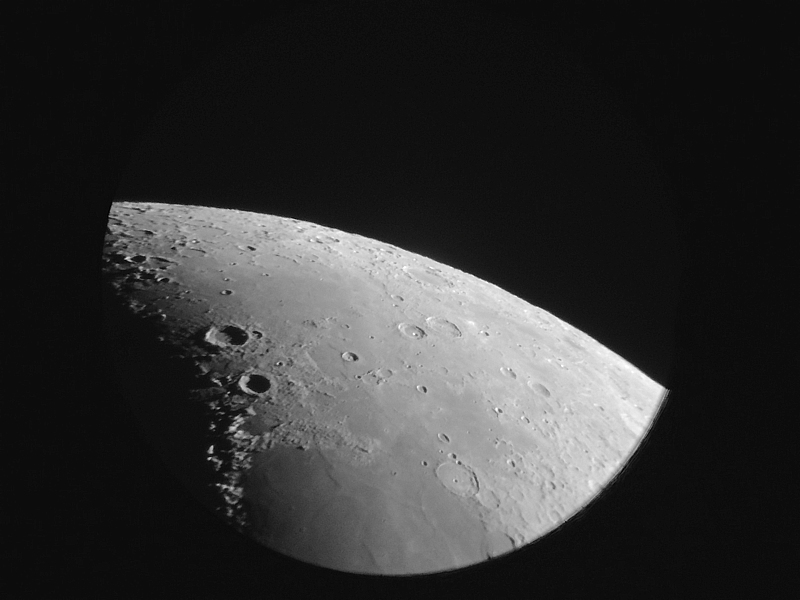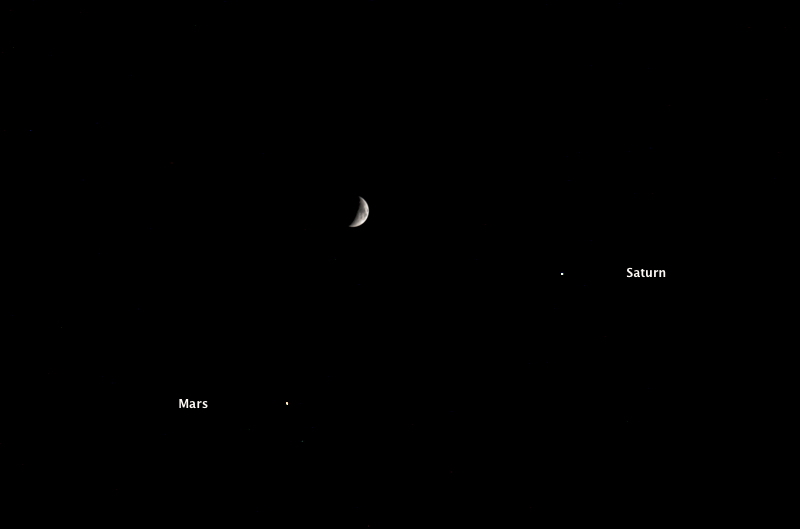Craters Atlas, Hercules, Aristoteles, Eudoxus; Rima Ariadaeus;
Bubble Nebula; M34
Posted: 1 September 2014
|
Opened: Sunday, 31 August 2014, 1850 MST Temperature: 95°F |
Session: 714 Conditions: Clear, some clouds low in north; breezy |
1850 MST: sunset. 1857 MST: viewed the moon, 83X and 222X. The craters Atlas and Hercules looked especially nice this night. Began setting up for iPhone 5s lunar imaging afocally on the 8" LX200-ACF using the MX-1 iPhone Afocal Adapter (modified for the iPhone 5s).
iPhone 5s, afocal 77X

iPhone 5s, afocal 154X, lunar northern region

iPhone 5s, afocal 222X, lunar northern region

iPhone 5s, afocal 444X, Craters Hercules (left) & Atlas (right), cropped

iPhone 5s, afocal 444X, Craters Aristoteles (left) & Eudoxus (right), cropped

As I was doing some lunar observing, 222X, I noticed the rille Rima Ariadaeus looked very distinct. This cropped iPhone 5s afocal 444X image clearly shows the rille:

1924 MST: ended iPhone imaging. The moon, Mars, and Saturn made a pretty triangle in the southwestern sky. This is a composite of two D7000 DSLR 105mm photos; f/5.6, 1/30sec, ISO 400 to capture Mars and Saturn, and f/5.6, 1/200sec, ISO 400, to capture the moon without overexposing:

1950 MST: ended lunar observing. Viewed Mars and Saturn, 222X. Mars showed no details, but Saturn's four moons Titan, Rhea, Dione, and Tethys were visible.
2045 MST: began observing M31 (Andromeda Galaxy) and its companion galaxies M32 and M110, 83X. Took a break 2052-2105 MST. 2124 MST: M31 was looking better at 83X now that it was higher in the eastern sky and the moon was lower in the western sky.
I began preparing to image NGC7635 (Bubble Nebula) in Cassiopeia. Mounted the D7000 DSLR at prime focus of the 8" LX200-ACF using an Off-Axis Guider. Did a focus test on the star Alpha Andromeda with a Bahtinov Mask. 2135 MST: slewed to NGC7635 and began searching for a good guide star. Did some framing test exposures, 3 minutes, ISO 6400, to confirm a selected guide star would have good framing of the nebula. Never got ideal framing but found a suitable guide star. 2222 MST: began a 20 minute, ISO 800, guided exposure of NGC7635 (Bubble Nebula). This is the (cropped) result:

2 September: thanks to a prompt from a site visitor, I processed the originally posted image above through Neat Image to remove the digital noise with this better result:

Thanks Fred!
2251 MST: slewed to M34 (open cluster), my next Messier object to image. Began waiting for it to get higher in the sky. Started imaging at 2315 MST. This is an unguided, 1 minute, ISO 400, exposure:

2325 MST: completed imaging. Viewed M34, 83X. Pretty.
|
Closed: Sunday, 31 August 2014, 2345 MST Temperature: 74°F |
|
Comments are welcome using Email. If you are on Twitter you can use the button below to tweet this report to your followers. Thanks.
Cassiopeia Observatory Home Page
Copyright ©2014 Michael L. Weasner / mweasner@me.com
URL = http://www.weasner.com/co/Reports/2014/09/01/index.html
